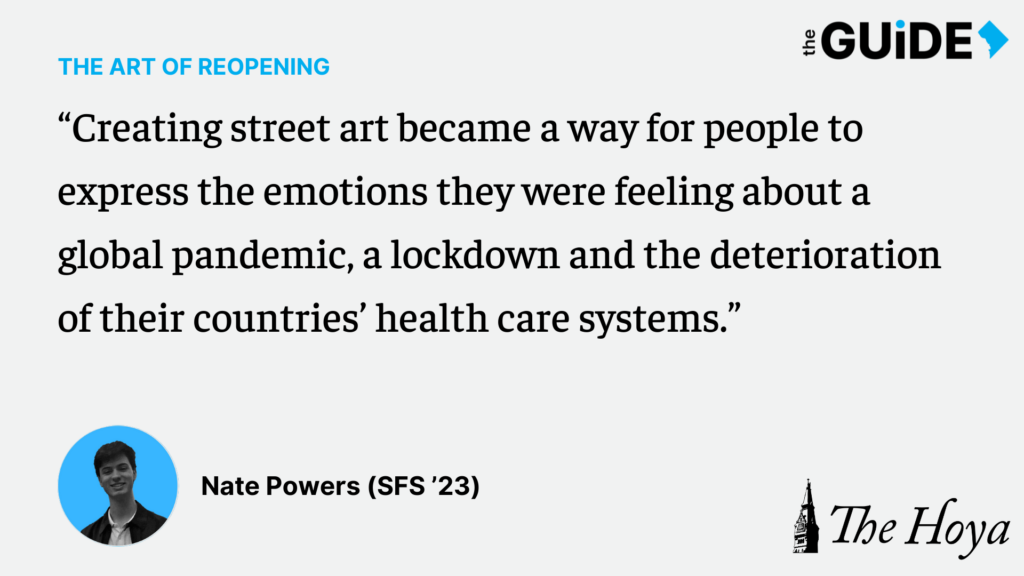Although widespread vaccination brings the reopening of art galleries across the globe, the COVID-19 pandemic has also left us with permanent reminders of a time when visual art seemed inaccessible. With museums shuttered indefinitely, the start of lockdown in March 2020 saw an increase in one type of artistic expression for which no gallery is necessary: street art.
Over the past year and a half, and especially in the first months of worldwide lockdown, pandemic-related street art has begun to pop up more frequently. For example, there has been a general increase in street art in the United Kingdom since early 2020, and as of June 2020, Washington, D.C. has 51 murals scattered throughout the city supporting statehood. Creating street art became a way for people to express the emotions they were feeling about a global pandemic, a lockdown and the deterioration of their countries’ healthcare systems.
In the international street art community, art that represents the interruption of daily life caused by the pandemic has become the new normal. In Norway, street artist Pobel created a powerful mural of a couple embracing. Despite their closeness, the couple is separated by the blue surgical masks they wear, symbolizing social distancing and a gap that cannot be closed.
Throughout the pandemic, street art has been used to process a variety of emotions, including gratitude. A notable example of street art depicting the importance of healthcare workers is a mural in Yorkshire created by artist Rachel List. The mural depicts a National Health Service nurse as a superhero, demonstrating the heightened role healthcare workers have played in everyone’s lives throughout the pandemic.
Objects that have donned special importance amid COVID-19 are also seen in street art. North Carolina artist Darion Fleming covered a wall in Charlotte, N.C., with a giant Purell hand sanitizer bottle, replacing hand sanitizer with liquid gold, aptly calling it “Pure’ll Gold.” In this artwork, an object that was normal before 2020 is newly celebrated.
Street art has always been viewed as a vehicle for self-expression and political dissent, often due to the fact that street artists are deliberately going against social norms by putting their creations on sidewalks and street corners. The lockdown, as well as civil unrest resulting from police brutality in the United States, has encouraged a new reflection on what it meant to push back against authority in 2020.
During the Black Lives Matter protests in the summer of 2020, in the midst of the pandemic, art served as a means of expression and social organization. In New York, giant murals depicting the words “Black Lives Matter” covered the streets of City Hall in Lower Manhattan and the uptown neighborhood of Harlem. Created by Tijay Mohammed, Sophia Dawson and Patrice Payne, the letters are filled with depictions of Black culture and community, as well as of the oppression of these communities. One letter features mothers in grief over child victims of police violence, while another includes the names of 24 Black individuals killed by the police. Other letters also include references to the Black community in Harlem and drawings of people protesting for the Black Lives Matter movement.
In an era when street art can become a type of performative activism, it is important to highlight where the artwork comes from. Some depictions of street art for the Black Lives Matter movement, like D.C. Mayor Muriel Bowser’s (D) yellow letters just outside the White House, are created by the government itself. This art distracts from more substantial change and signals a desire to solve historical injustice through a single action, an obviously flawed approach.
In spite of these complexities within the act of creating street art, throughout the duration of the pandemic, street art has been a risk-free way for people to express themselves politically and generate conversations many were unwilling to have. Regardless of their subject matter, these creations allow communities to generate conversation about issues that impact them, even while socially distanced. Now, the streets themselves are a museum of the pandemic and will generate remembrance and reflection for years to come.














